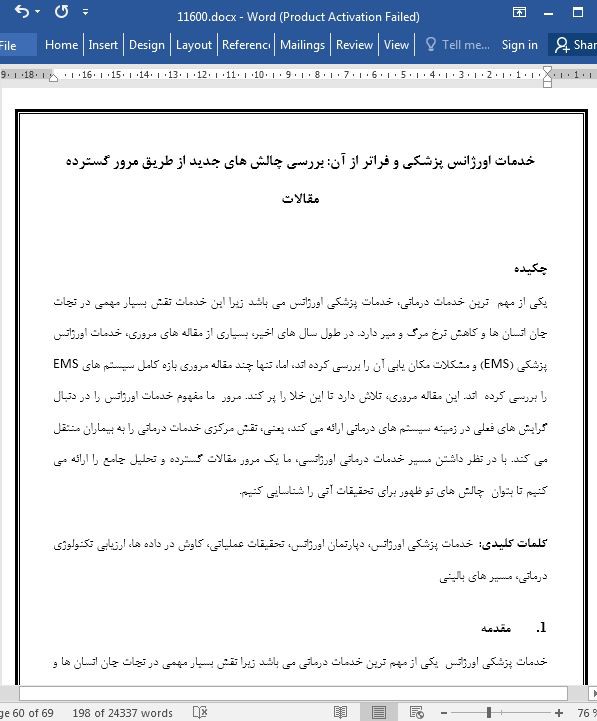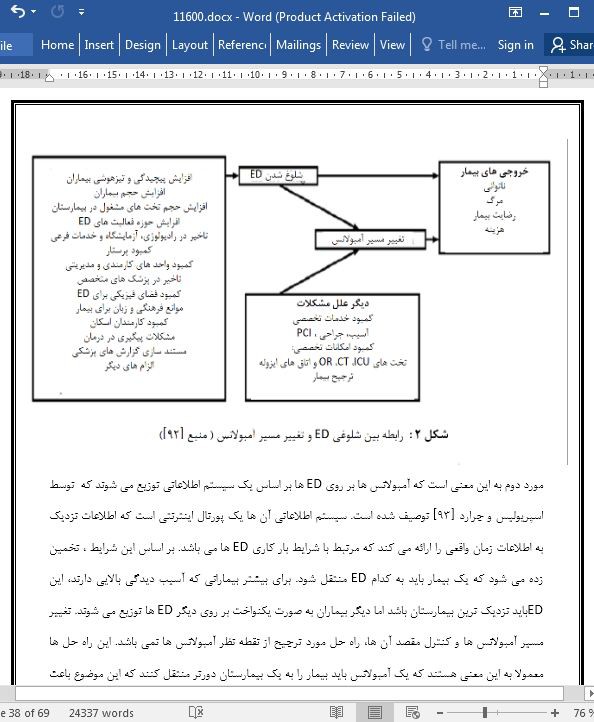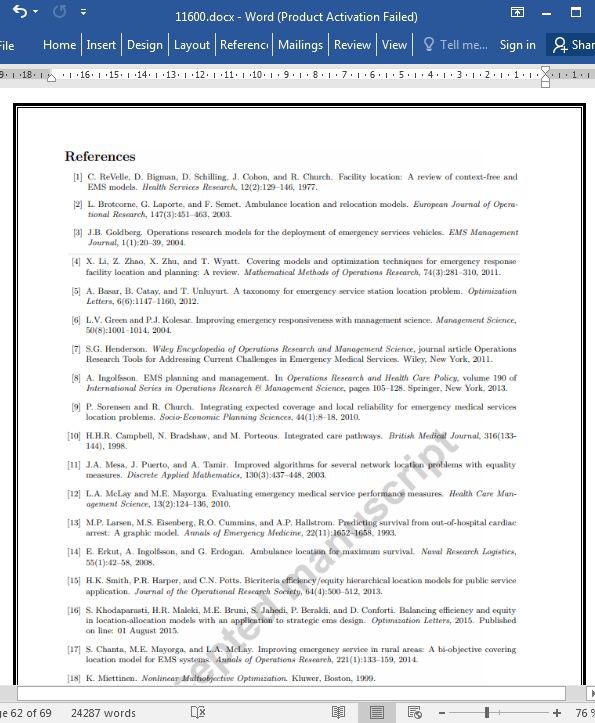
خدمات اورژانس پزشکی و فراتر از آن
چکیده
یکی از مهم ترین خدمات درمانی، خدمات پزشکی اورژانس می باشد زیرا این خدمات نقش بسیار مهمی در نجات جان انسان ها و کاهش نرخ مرگ و میر دارد. در طول سال های اخیر، بسیاری از مقاله های مروری، خدمات اورژانس پزشکی (EMS) و مشکلات مکان یابی آن را بررسی کرده اند، اما، تنها چند مقاله مروری بازه کامل سیستم های EMS را بررسی کرده اند. این مقاله مروری، تلاش دارد تا این خلا را پر کند. مرور ما مفهوم خدمات اورژانس را در دنبال گرایش های فعلی در زمینه سیستم های درمانی ارائه می کند، یعنی، نقش مرکزی خدمات درمانی را به بیماران منتقل می کند. با در نظر داشتن مسیر خدمات درمانی اورژانسی، ما یک مرور مقالات گسترده و تحلیل جامع را ارائه می کنیم تا بتوان چالش های نو ظهور برای تحقیقات آتی را شناسایی کنیم.
1. مقدمه
خدمات پزشکی اورژانس یکی از مهم ترین خدمات درمانی می باشد زیرا نقش بسیار مهمی در نجات جان انسان ها و کاهش وضعیت مرگ و میر و ناتوانی دارد. اهمیت و حساسیت تصمیم گیری در خدمات پزشکی اورژانس (EMS) توسط دانشمندان علوم عملیاتی، برنامه ریزان EMS و فعالان در زمینه خدمات درمانی که مسئله های مرتبط با مدیریت سیستم های EMS را از دهه 1960 بررسی کرده اند، شناسایی شده است.
مکان یابی وسایل نقلیه EMS به صورت گسترده مورد بررسی قرار گرفته است زیرا در بسیاری از مقالات نشان داده شده است که این موضوع، اهمیت بسیار زیادی دارد. یکی از اولین مقاله های مروری که مدل های مکان یابی EMS را بررسی کرده است، مقاله ReVelle و همکارانش [1] می باشد. Brotcorne و همکارانش [2] یک مرور بر مقالات مکان یابی آمبولانس و مسئله های مکان یابی مجدد را ارائه کرده اند و مدل های موجود را در سه دسته کلی، تقسیم بندی کرده اند: مدل های ایستا و معین، مدل های احتمالی، و مدل های پویا. Goldberg [3] مدل های تحقیقات عملیاتی را برای استفاده از وسیله های EMS بررسی کرده است در حالی که بر روی مدل سازی ابعاد و فرضیات مسئله تمرکز کرده است. در این مقاله های مروری، چالش های مطرح شده توسط کاربرد های واقعی، خلا های احتمالی در مقالات و گرایش های جدید مورد بررسی قرار گرفته است.
9. EMS بزرگ، داده های بزرگ و چالش های بزرگ
در قسمت های قبلی، بسیاری از چالش ها مورد ارزیابی قرار گرفت مانند چالش های موجود که در زمان کار با مسئله برابری و ابعاد عدم قطعیت ، نیاز برای پیش بینی قابل اعتماد و روش های جدید برای ترکیب، ایجاد شد.
به نظر ما، بزرگترین چالش این است که یک رویکرد مبتنی بر نتیجه کلی برای ECP اتخاذ شود، که باید به عنوان یک روش شناخته شده که تمام تصمیم ها، درمان ها و گزارش های مربوط به یک بیمار را در بر می گیرد، تصدیق شود. از این منظر، یکی از اصلی ترین موارد جمع آوری اطلاعات مربوط به همه حوادث مربوط به بیمار قبل، در طی و پس از مداخله EMS است. معمولا سیستم های EMS مقدار زیادی از داده ها را جمع آوری می کنند، اما این اطلاعات مربوط به آنچه اتفاق می افتد قبل و بعد از دخالت وسیله نقلیه EMS را شامل نمی شود. بنابراین، چالش اصلی این است که مدل های قابل اطمینان جدید (احتمالا مدل های ترکیبی و با پشتیبانی از راه حل های جدید ICT) به دست بیاید که بتوانند پیچیدگی ذاتی را در کنار تعریف ECP نشان دهند.
Abstract
One of the most important health care services is emergency medical service as it plays a vital role in saving people's lives and reducing the rate of mortality and morbidity. Over the last years, many review papers have discussed emergency medical services (EMS) location problems, however, only few review papers consider the full range of EMS systems. This review paper tries to fill this gap. Our review introduces the concept of emergency care pathway following the current trend in health care systems, i.e., shifting the central role from health care providers to patients. Considering the emergency care pathway, we provide a broad literature review and analysis in order to identify emerging challenges for future research.
1 Introduction
Emergency medical service is one of the most important health care services as it plays a vital role in saving people’s lives and reducing the rate of mortality and morbidity. The importance and sensitivity of decision making in the Emergency Medical Services (EMS) field have been recognized by operations research scientists, EMS planners, and health care practitioners who studied many problems arising in the management of EMS systems since the 1960s.
Locating EMS vehicles has been widely studied as is shown by numerous review papers that appeared over the last years. One of the first review papers that addressed EMS location models is the paper of ReVelle et al. [1]. Brotcorne et al. [2] presented a review paper on ambulance location and relocation problems, and classified the existing models in three main groups: static and deterministic models, probabilistic models, and dynamic models. Goldberg [3] surveyed operations research models for the deployment of EMS vehicles while focusing on modeling aspects and problems assumptions. In these review papers, challenges posed by real world applications, potentials gaps in the literature, and new trends have been addressed.
9 Big EMS, big data, big challenge
In the previous sections, many challenges were highlighted such as those arising when dealing with the problem of incorporating equity and uncertainty aspects, the need for reliable forecasts and new methodological hybridizations.
In our opinion, the biggest challenge is to adopt a holistic outcome-based approach for the ECP, which should be conceived as a methodology that details all decisions, treatments, and reports related to a patient. From this point of view, one of the main difficulties is the collection of information regarding all events involving the patient before, during and after the EMS intervention. Usually, EMS systems collect a large amount of data, but this does not include data on what happens before and after the involvement of an EMS vehicle. Therefore, the main challenge is to develop new reliable models (probably hybrids and supported by new ICT solutions) that are capable to represent the inherent complexity behind the definition of an ECP.
چکیده
1. مقدمه
2. مکان آمبولانس ها
2.1 برابری در ترکیب
2.2 عدم قطعیت در ترکیب
3. مکان یابی مجدد آمبولانس ها
4. سیاست های اعزام و مسیر یابی
4.1 استراتژی های اعزام
4.2 مسئله مسیر یابی آمبولانس
5. تعامل بین دیگر سیستم های ارائه خدمات درمانی اورژانسی
5.1 دپارتمان های اورژانس
5.2 سیستم های خدمات درمانی 5 اولویت در اولین ساعت
6. ارزیابی و اعتبار سنجی
6.1 ارزیابی
6.2 اعتبار سنجی
7. پیش بینی
7.1 پیش بینی نیاز
7.2 پیش بینی زمان سفر و بار کاری
8. مدیریت نیروی کار
9. EMS بزرگ، داده های بزرگ و چالش های بزرگ
منابع
Abstract
1 Introduction
2 Location of ambulances
2.1 Incorporating equity
2.2 Incorporating uncertainty
3 Relocation of ambulances
4 Dispatching and routing policies
4.1 Dispatching strategies
4.2 Ambulance routing problem
5 Interplay with other emergency health care delivery systems
5.1 Emergency departments
5.2 First Hour Quintet care systems
6 Evaluation and validation
6.1 Evaluation
6.2 Validation
7 Forecasting
7.1 Forecasting the demand
7.2 Forecasting travel times and workloads
8 Workforce Management
9 Big EMS, big data, big challenge
References
- اصل مقاله انگلیسی با فرمت ورد (word) با قابلیت ویرایش
- ترجمه فارسی مقاله با فرمت ورد (word) با قابلیت ویرایش، بدون آرم سایت ای ترجمه
- ترجمه فارسی مقاله با فرمت pdf، بدون آرم سایت ای ترجمه



